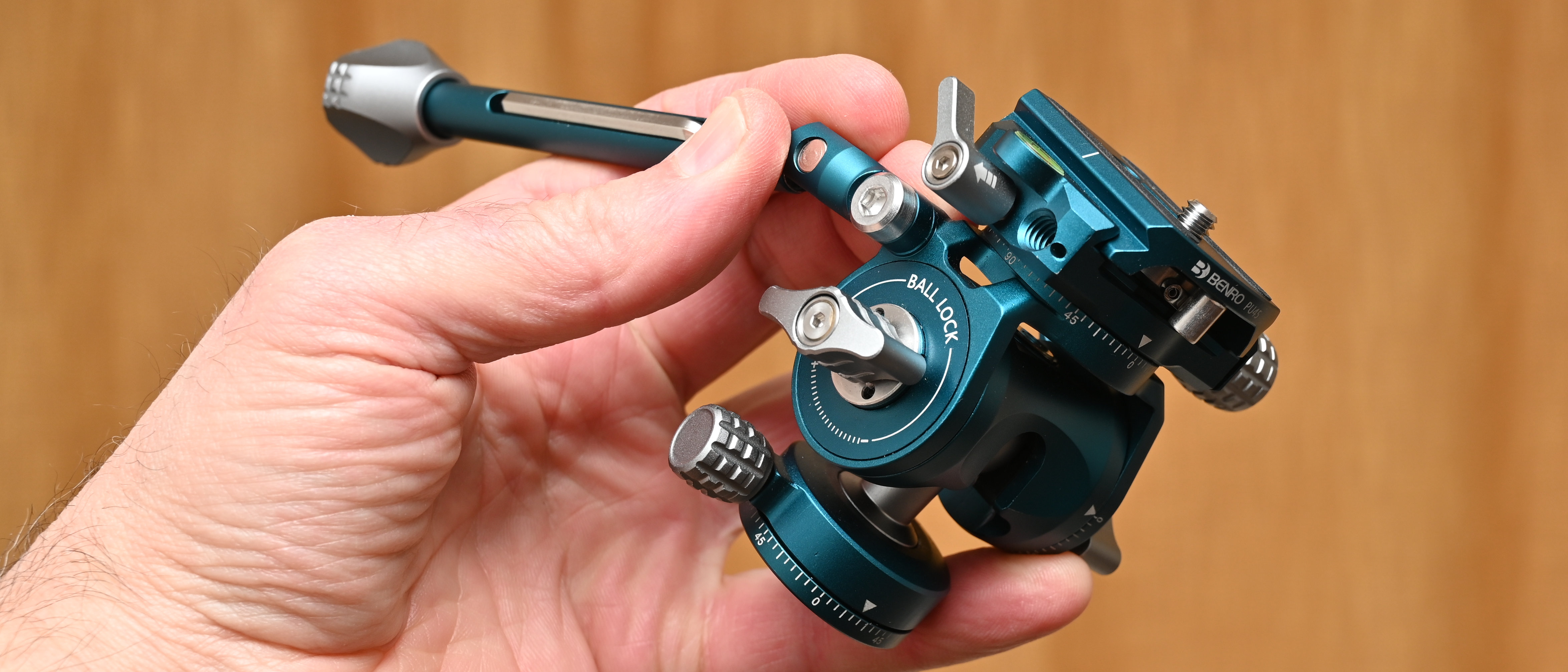Best Canon flashgun: which Speedlite will be best for you?
Our comprehensive guide will help you choose the best Canon flashgun that suits your needs and budget
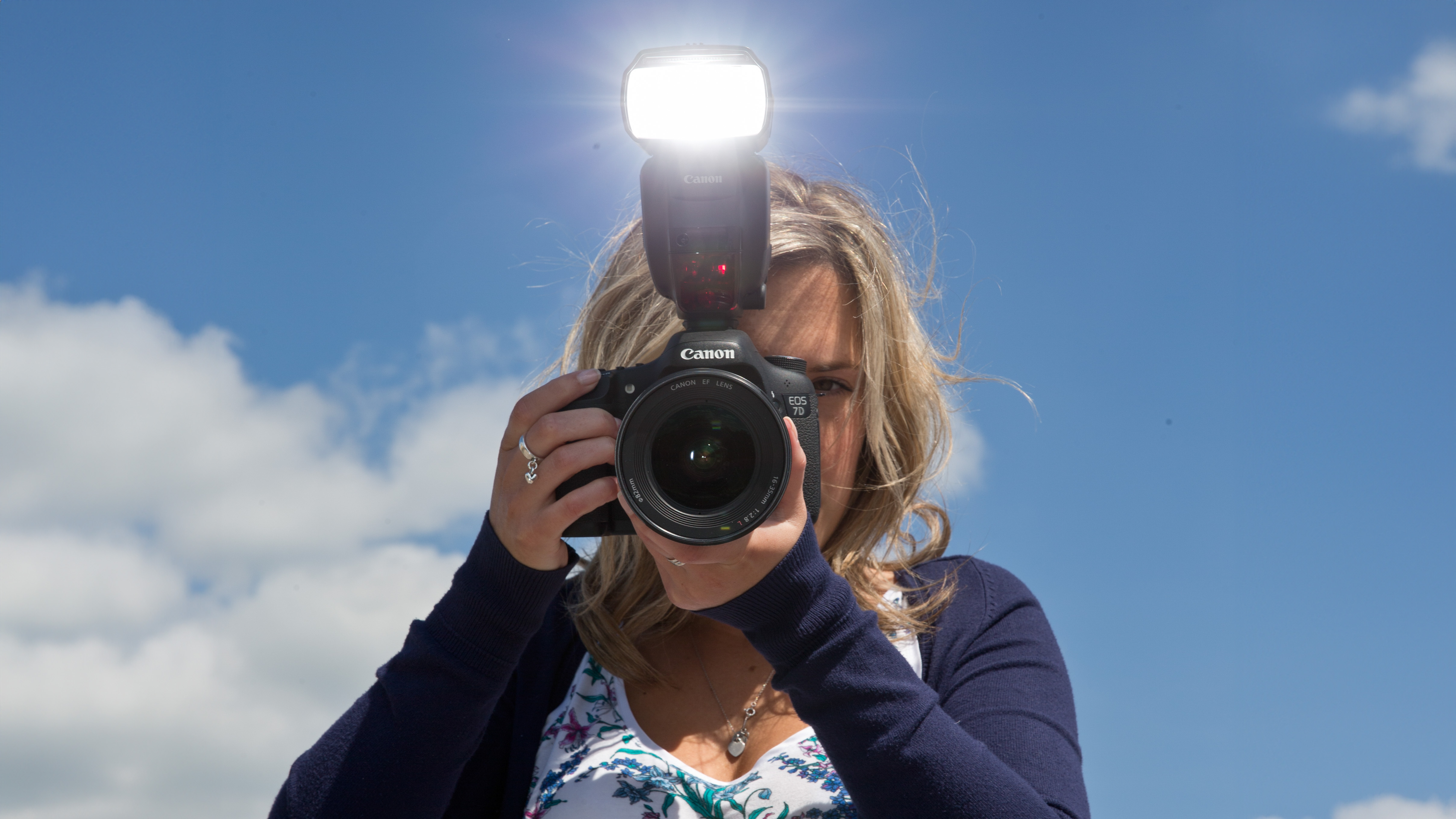
If you're looking for the best Canon flash units, you're in the right place. In this guide, we're taking an up-to-date look at the Canon Speedlite range, from beginner units to the current flagship professional Speedlite. Also known as flashguns and strobes, these units can enhance pretty much any shooting scenario, and have many more functions than simply providing a bit of extra illumination.
As a seasoned DCW reviewer, I've tested all the latest Canon Speedlites, and have used my findings to inform the rankings and ratings in this guide. Bear in mind I've only focused on Canon-made products here – if you want more choice from independent manufacturers like Godox, Hahnel or Nissin Digital, you can check out the full best flashguns buying guide, which includes plenty of options for Canon.
I've restricted this guide just to Speedlites that Canon still sells, but there are some discontinued models you may want to consider picking up second-hand – check out my full Canon Speedlite 470EX-AI and Canon Speedlite 600EX RT-II reviews to learn more. If you need more lighting power, you may also want to check out our guide to the best lighting kits for professional studio or location photography. For now though, let's get into the Speedlites.
The quick list

Best flashgun overall
With amazing stamina, super-fast recycle speeds and a weatherproof build, the Speedlite EL-1 is the best flashgun for professionals – and is priced as such.
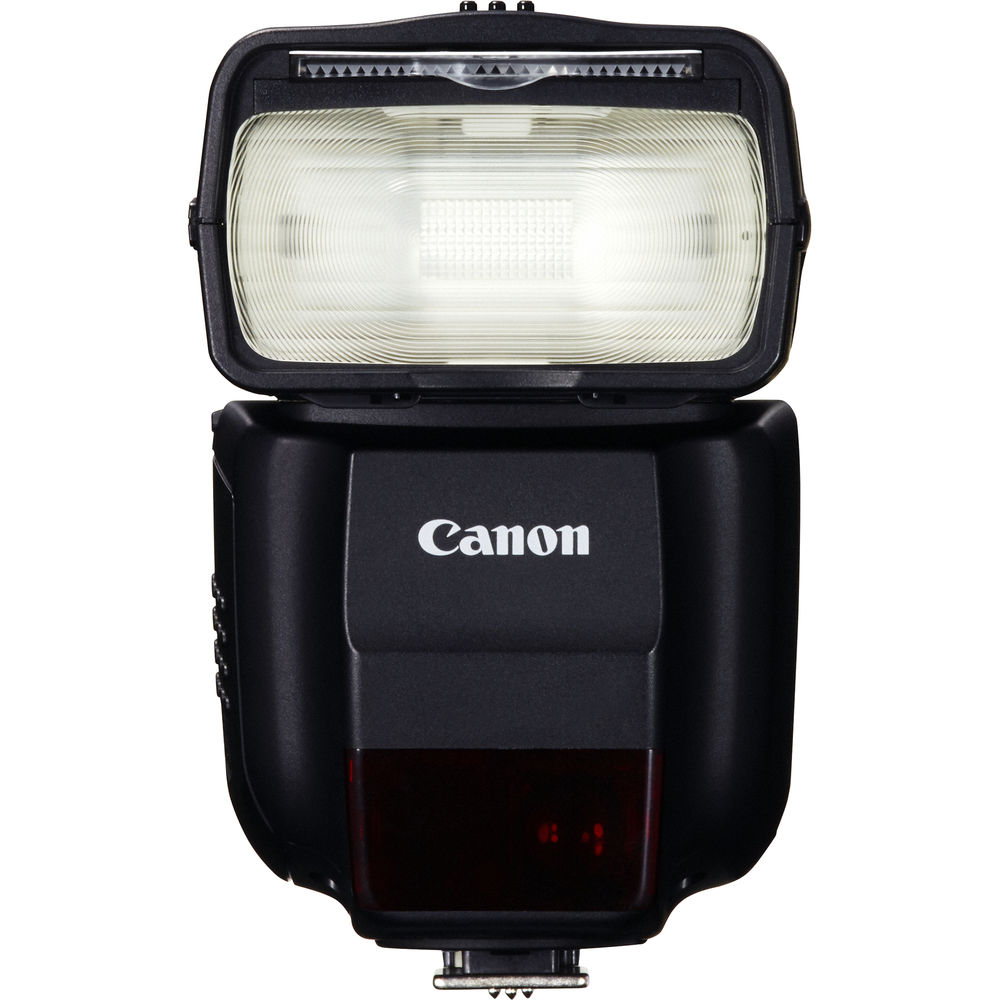
Best mid-range flashgun
While it's both compact and reasonably priced, the Canon Speedlite 430EX III-RT still packs in plenty of features, with a motorised zoom and RF master/slave functions.
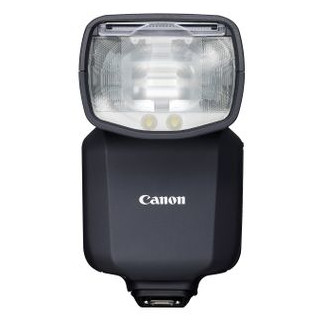
Best flashgun for EOS R
This flashgun is compatible with Canon's 'multi-function shoe', meaning it'll only work with certain cameras. If you have a newer EOS R model, it's an excellent choice.
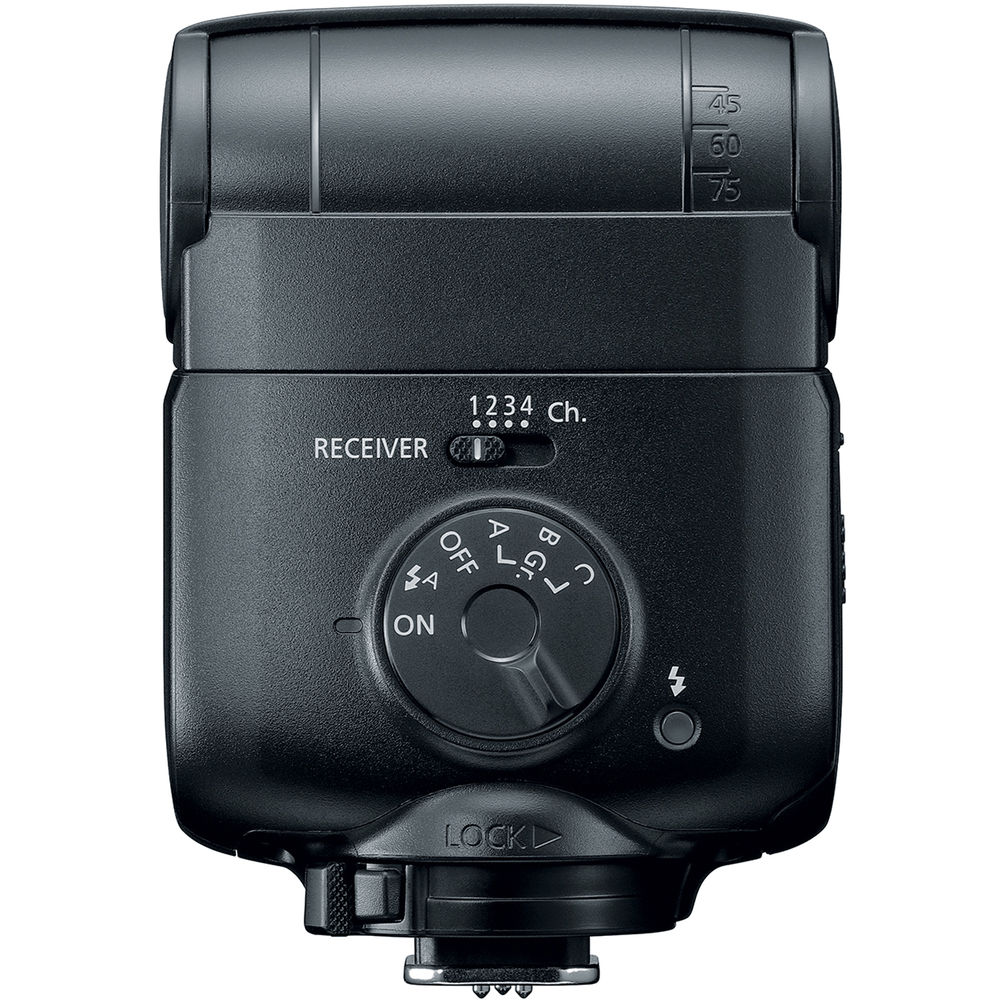
Best for beginners
This pocketable Speedlight is just the thing for budget-conscious users who don't need anything too flashy (pun intended). It's great value for money.
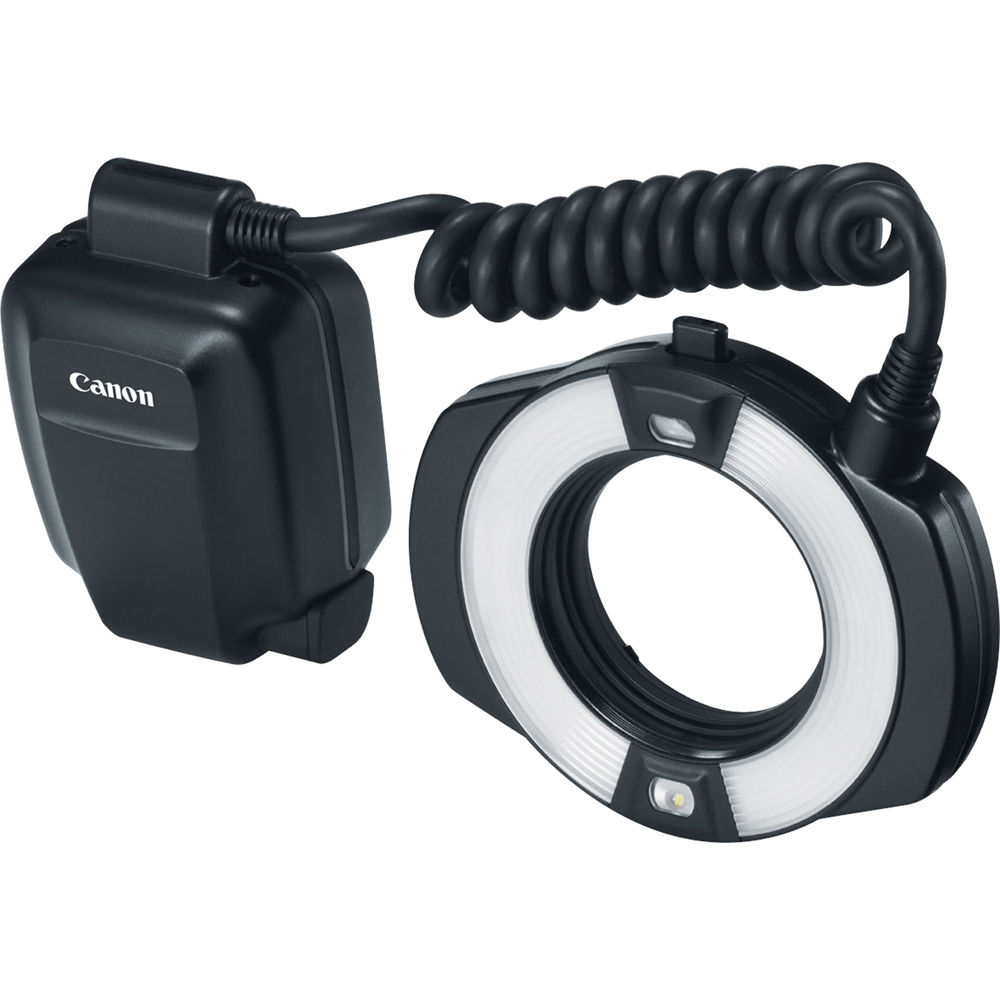
Best cheap macro flashgun
Ideal for capturing close-up images on a budget, the the MR-14EX II delivers even, shadowless lighting, with independent left/right control for precision.
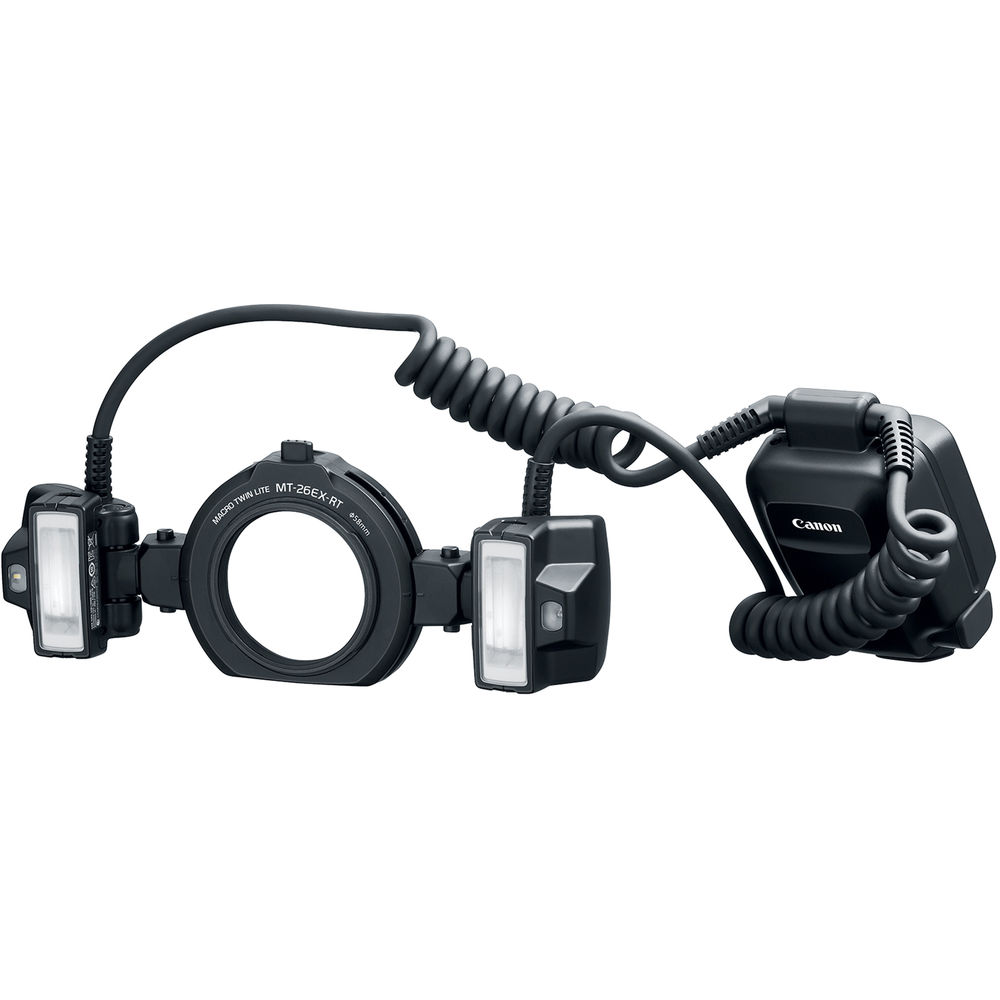
Best macro flashgun
A pricier proposition than the MR-14EX II, but the MT-26EX-RT offers a high level of performance, with infrared and RF master modes, and much more power.

Matthew Richards is a photographer and journalist who has spent years using and reviewing all manner of photo gear. As well as being Digital Camera World's principal lens reviewer, he also brings his expert's eye to the best accessories – and has personally tested the Canon Speedlites in this guide.
The best Canon flashguns
Why you can trust Digital Camera World
Best Canon Speedlite overall
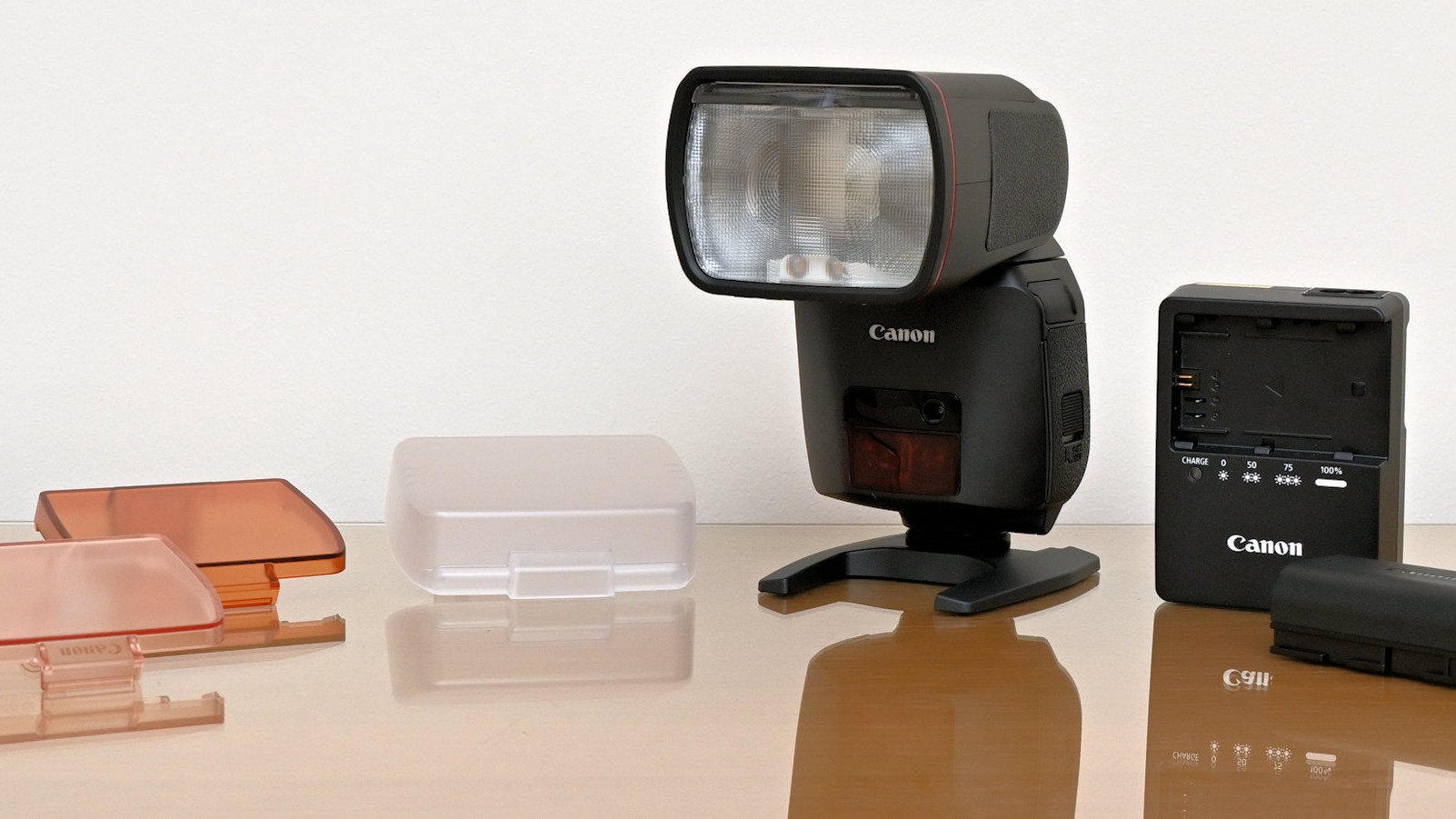
Specifications
Reasons to buy
Reasons to avoid
✅ Top-of-the-Line Performance: Canon's flagship flashgun designed for demanding professional photographers.
✅ Fan-Driven Cooling System: Supports continuous shooting for up to 170 full-power flashes, enhancing durability and reliability.
❌ High Cost: More expensive than most other flashguns, which may be a significant consideration for many users.
❌ Heavy and Bulky: Its robust design and battery pack can make it heavier and bulkier compared to more compact flash options.
The Speedlite EL-1 reigns supreme in Canon’s Speedlite line-up, especially now that the 600EX II-RT has been discontinued. As Canon's flagship flashgun, the EL-1 is designed to meet the challenges that the most demanding professional photographers can throw at it. It’s built for endurance and dependability, with a weather-resistant design that uses sealing similar to that of top Canon cameras. We love the top-quality feel of this flashgun and it’s reassuring to be able to shoot in any weather. For example, you can’t weddings and other events on hold just because of a few raindrops.
We really like the stamina of this Speedlite. It runs on a rechargeable Li-ion battery pack instead of the more conventional array of four AA batteries. We found the flashgun kept going for around 330 full-power flashes from a fully charged battery, which also enables super-fast recycling speeds of just under a second, even after a full-power flash. Another plus point for stamina is that the EL-1 features a new fan-driven cooling system, enabling continuous shooting for up to 170 full-power flashes.
To enhance durability, accuracy, and consistency, we’re impressed that the EL-1 has a specially designed Xenon flash tube. This also enables manual power settings right down to 1/8192 power for really subtle flash effects. That’s a particular challenge for flashgun technology. As you’d expect, it boasts a full range of flash modes including a programmable strobe, a red AF-assist lamp plus an LED lamp, and full RF and infrared wireless master/slave modes. The only real sticking point is that the EL-1 costs more than most of us would be willing to pay for a flashgun.
You can read my full Canon Speedlite EL-1 review for more information.
Best mid-range Canon Speedlite
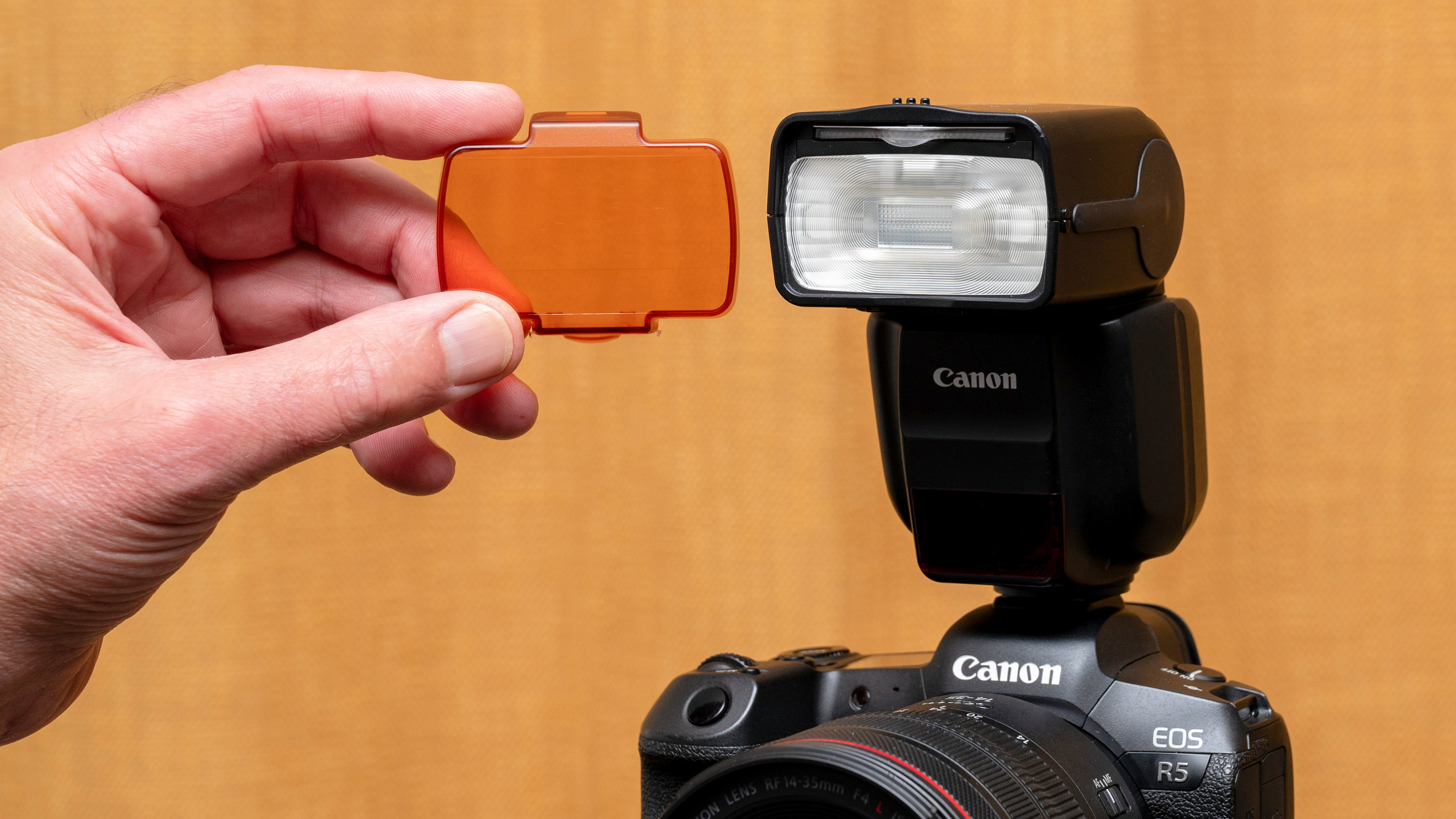
Specifications
Reasons to buy
Reasons to avoid
✅ Compact and Affordable: Offers a more budget-friendly alternative to the Canon Speedlite EL-1 while still providing a rich feature set.
✅ Swift Recycling Speed: Despite using AA batteries, it has a relatively fast recycling time of around 2.5 seconds with NiMH batteries.
❌ Limited Wireless Infrared Mode: Only supports wireless infrared slave mode, meaning it cannot trigger other Speedlites that rely solely on infrared wireless linking.
❌ Battery Type: Runs on AA batteries rather than a Li-ion battery pack, which may affect the convenience and longevity compared to higher-end models.
For all of us whose pockets aren’t deep enough for the Canon Speedlite EL-1 (physically and moneywise), the 430EX III-RT is the next best option. It’s relatively compact and affordable, but we love its rich range of features and its wonderfully intuitive interface, based on a backlit screen and smart selection of control buttons and dials.
Unlike the more basic Canon Speedlite EL-100, this one has a larger zoom range of 24-105mm, and it’s motorized instead of being a manual push-pull affair. As such, it uses dedication to track the lens’s focal length or zoom setting that’s mounted on the camera, along with automatic sensing that caters to both APS-C format and full-frame cameras.
Considering that the 430EX III-RT runs on AA batteries rather than a Li-ion battery pack, recycling speed is pretty swift even after a full-power flash, at around 2.5 seconds if you use NiMH batteries. The Speedlite is supplied complete with a diffusion dome, which is useful for softening the quality of light, and you also get a color filter for matching the color temperature of the flash to tungsten ambient lighting. Full wireless RF (Radio Frequency) master/slave functions are available for use with other compatible Speedlites, including the now discontinued 600EX II-RT, although there’s only a wireless infrared slave mode, so you can’t use this Speedlite to trigger others that only work via infrared wireless linking.
See more of what I thought of this flashgun in the full Canon Speedlite 430EX III-RT review.
Best Canon Speedlite for EOS R cameras
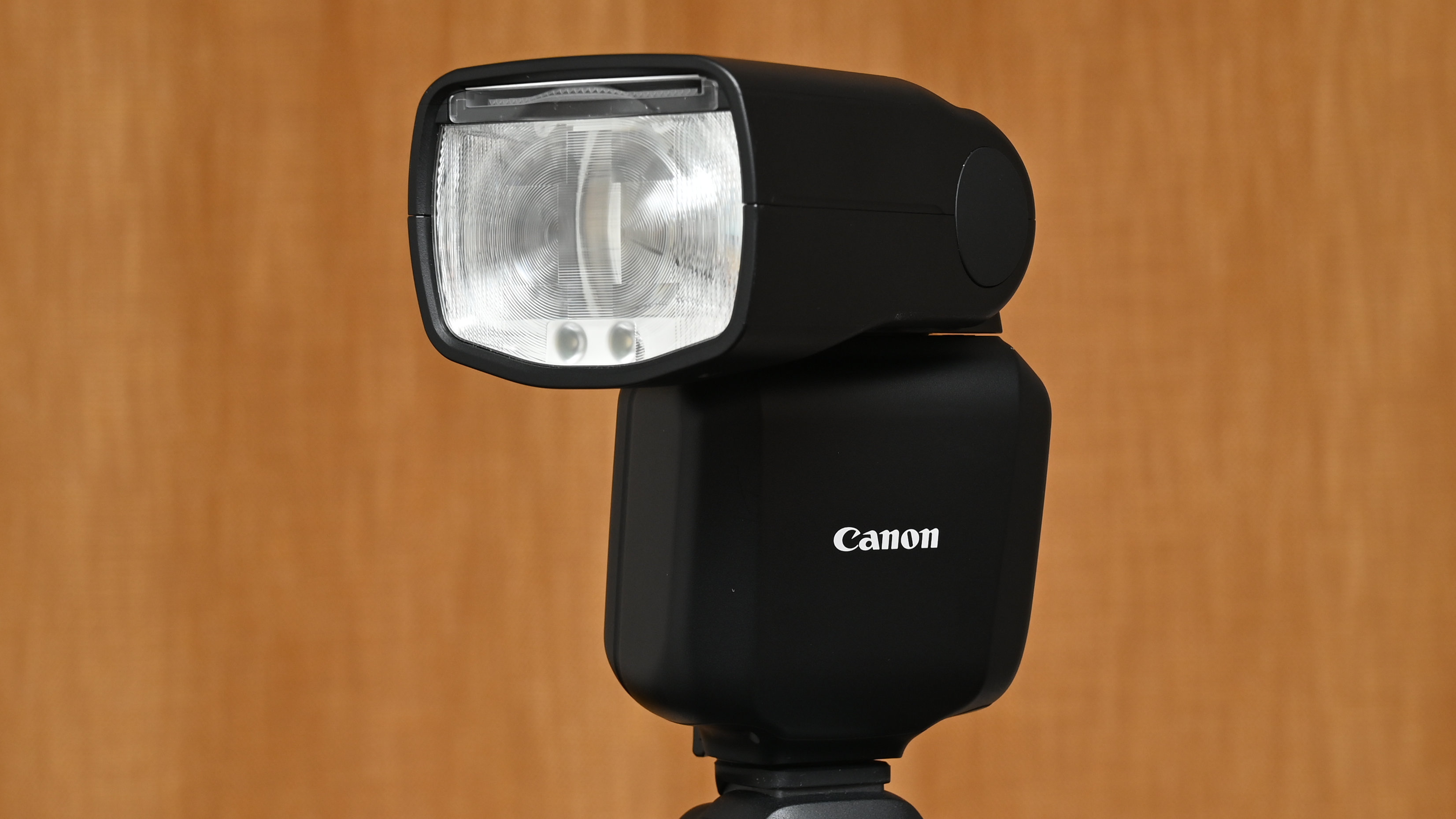
Specifications
Reasons to buy
Reasons to avoid
✅ Designed for EOS R-System: Tailored for Canon's EOS R-series mirrorless cameras, leveraging the new ‘Multi Function Shoe’ for advanced features.
✅ Wide Zoom Range: Offers an impressive zoom range of 20-200mm in full-frame terms.
❌ No Charger Included: Does not come with a charger for the Li-ion battery pack, which can be inconvenient if your camera uses a different charger or if you want to charge both simultaneously.
❌ Limited Compatibility: Only works with newer EOS R cameras that feature the Multi Function Shoe, excluding older models like the EOS R5 and original EOS R6.
This is Canon’s latest Speedlite and there’s a lot we like about it. It’s the first in the line-up to be designed for EOS R-system mirrorless cameras rather than DSLRs. It’s no surprise then that there’s no red AF-assist beam, which doesn’t work with mirrorless cameras. We’re more surprised that it’s not compatible with the whole range of EOS R cameras. That’s because it’s designed to take advantage of Canon’s new ‘Multi Function Shoe’. However, that rules out use with older EOS R cameras, including the EOS R5 and original EOS R6.
The EL-5 is intended for newer bodies including the EOS R3, R6 Mark II, R7, R10 and onwards, all of which feature the Multi Function Shoe. We’re disappointed that the Speedlite isn’t supplied with a charger for its Li-ion battery pack. It’s a definite drawback if your camera doesn’t use a compatible LC-E6 charger, or if you want to charge the batteries for your camera and Speedlite at the same time.
What we do like is the powerful Gn 60 rating (ISO 100, meters) at its longest zoom setting. The zoom range itself is impressive as well, stretching all the way from 20-200mm in full-frame terms. We love the inclusion of an LED modelling lamp, which also serves as AF-assist for mirrorless cameras. Wireless RF master/slave modes are included, albeit with a modest range of 30m, compared with around 100m for some independent flashguns. As well as the high-end maximum power, we like that it’s adjustable right down to 1/1024 for really subtle fill-in flash.
Read my full Canon Speedlite EL-5 review to find out more.
Best Canon Speedlite for beginners
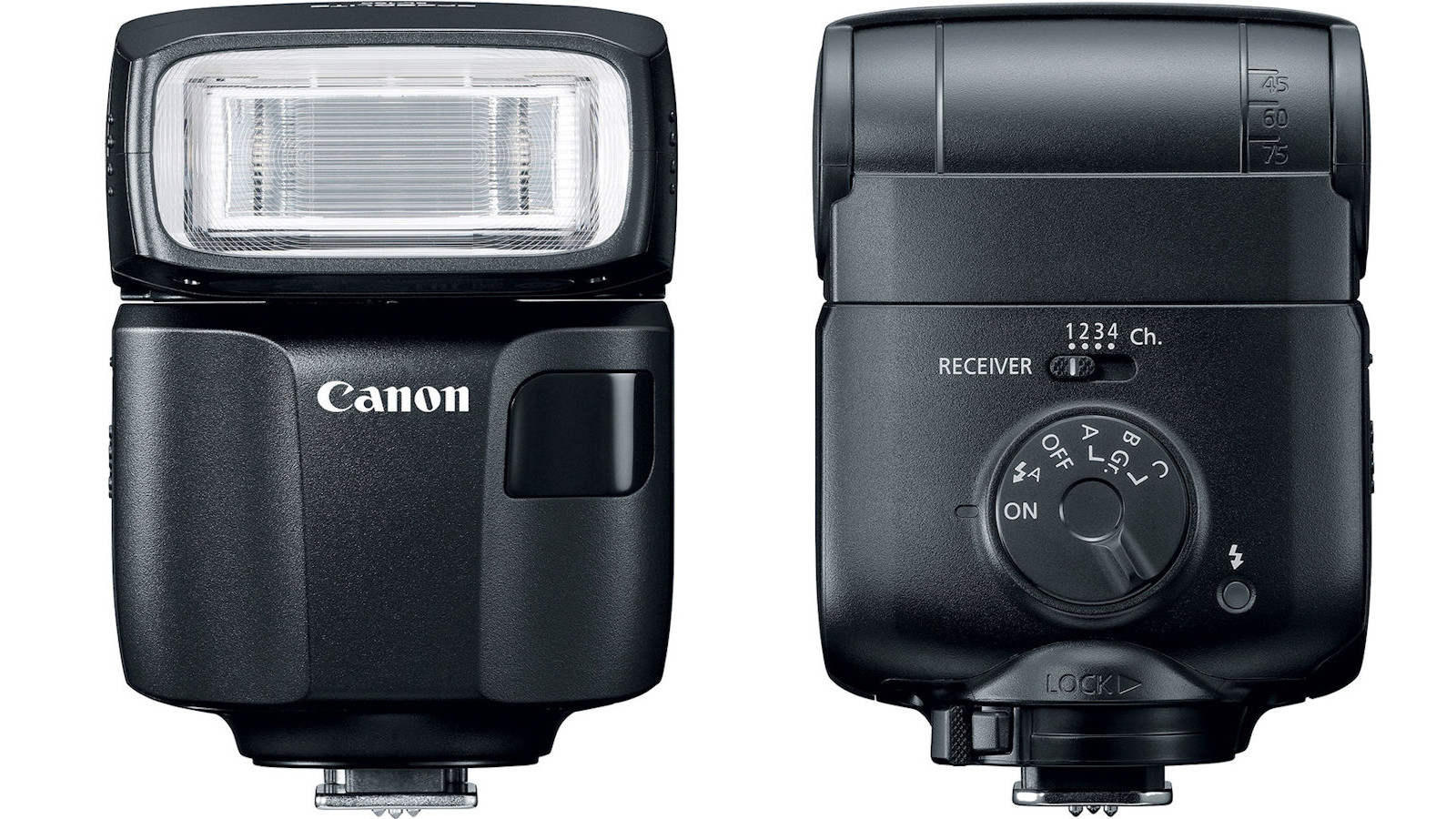
Specifications
Reasons to buy
Reasons to avoid
✅ Versatile Flash Modes: Includes high-speed sync, rear-curtain sync, and a programmable stroboscopic mode, which is not available on some higher-end models.
✅ Affordable: Provides a range of features at a lower price point compared to more expensive models.
❌ No Wide-Angle Diffuser or Catchlight Card: Does not include these accessories, which could limit its versatility.
❌ Slow Recycling Time: Recycling time is relatively slow, at 3 seconds after a full-power flash with NiMH batteries (5.2 seconds with alkaline batteries).
One of the things we like best about this Speedlite is that it’s just about small enough to slip into a coat pocket. It’s certainly easier to find room for than a big, chunky flashgun when you’re out and about. Although compact, the flashgun features a bounce head, with 0-90 degrees of vertical movement, and 150/180 degrees of swivel to the left and right. However, there’s no motorized zoom. Instead a rudimentary push-pull manual adjustment gives alternatives to match focal lengths of 24mm or 50mm focal lengths (38mm or 80mm for APS-C). We also miss the wide-angle diffuser panel and catchlight card, which aren’t featured, it does come with a carrying pouch and stand.
We’re impressed that the little EL-100 packs a wealth of flash modes, including high-speed sync, rear-curtain sync and even a programmable stroboscopic mode, the last of which is lacking on the more up-market 430EX III-RT. Wireless master and slave modes are available via infrared linking but there’s no RF connectivity.
We’re not so keen on the onboard controls, which are very rudimentary, only really catering to channel and group assignments for wireless modes, and there’s no LCD screen. We find it can be more convoluted, needing to constantly dip into menus on the host camera to make adjustments. Maximum power output is modest, compared with other Canon Speedlites and, based on just two AA batteries, recycling isn’t very fast at 3 seconds after a full-power flash when using NiMH batteries (5.2 seconds for alkaline). Even so, it’s a smart little Speedlite, with ‘lite’ being the operative word for travel-friendliness.
You can see more of my thoughts in the full DCW Canon Speedlite EL-100 review.
Best Macro Speedlite on a budget
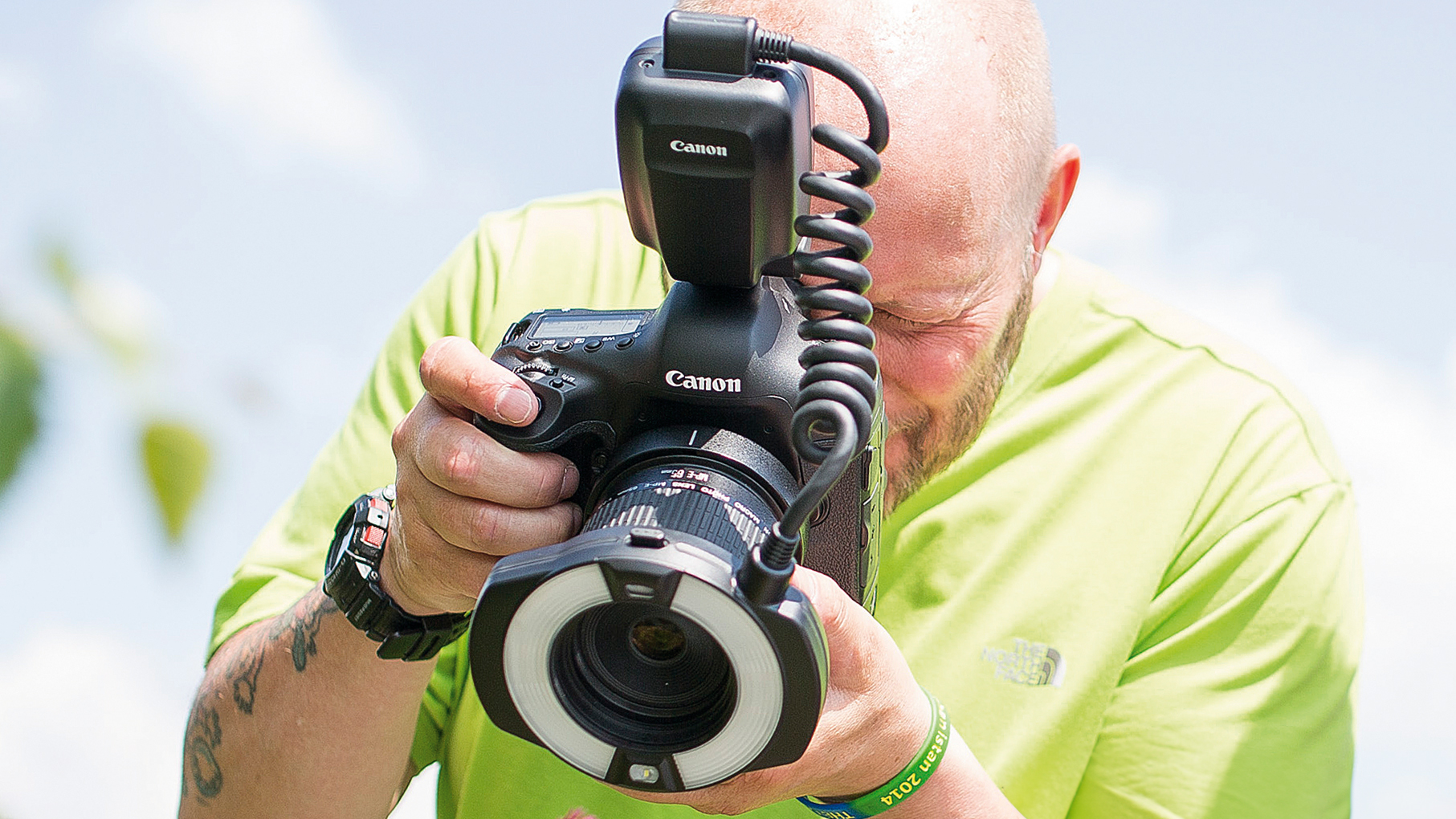
5. Canon Macro Ring Lite MR-14EX II
Specifications
Reasons to buy
Reasons to avoid
✅ Even Lighting for Macro Photography: The MR-14EX II provides beautifully even, shadowless lighting, ideal for close-up and macro shots.
✅ Adjustable Flash Tubes: Allows for independent adjustment of the power output of the semi-circular flash tubes, enabling both shadowless lighting and customizable shadow effects.
❌ Limited Attachment Options: May require a separate Macro Lite Adapter for some lenses, adding extra cost and complexity.
❌ Price: Typically more expensive compared to standard Speedlites, reflecting its specialized functionality and features.
Regular Canon Speedlites are less than ideal for extreme close-ups and macro photography. When mounted in a camera’s hot shoe, the flash tube sits high above the axis of the lens, so uneven lighting with deep shadows can plague macro shots. The MR-14EX II puts that to rights. It’s based on a separate hot shoe-mounting control unit and a circular flash head that mounts around the front of a lens.
We love that the MR-14EX II can deliver beautifully even, shadowless lighting for macro photography. The mounting system is directly compatible with most of Canon’s macro lenses. However, you might need a 67mm or 72mm attachment thread ‘Macro Lite Adapter’ to suit some lenses.
As they say, power is nothing without control. We’re impressed that you can rotate the flash tubes on the lens for changing the effect. In normal configuration, the two semi-circular flash tubes sit on the left and right, and you can adjust their power output independently. This not only enables shadowless macro lighting when both sides have equal power, but gives the option of adding shadows to give a more three-dimensional effect. We also like the LED modeling lamps at the top and bottom, which are really helpful for composition and accurate focusing.
Best high-performance Macro Speedlite
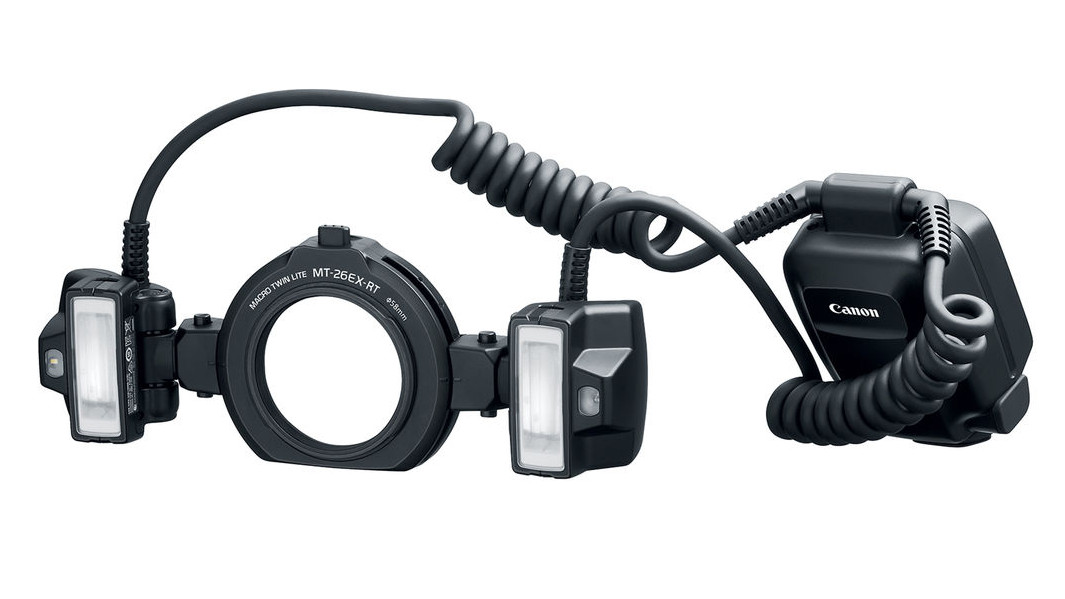
Specifications
Reasons to buy
Reasons to avoid
✅ Increased Power: The newer model has a higher guide number (Gn 26) compared to the older MR-14EX II (Gn 14), providing more light output, which is useful for narrow aperture settings in macro photography.
✅ Wireless Triggering: Capable of triggering other compatible Speedlites using either infrared or RF wireless communication.
❌ Loss of Classic Effect: The twin flash head design does not replicate the classic ring light effect used in portraiture for halo-shaped catchlights in the eyes.
❌ High Price: Nearly twice as expensive as the MR-14EX II Macro Ring Lite, which might be a significant investment for some users.
Much more powerful than Canon’s older MR-14EX II Macro Ring Lite, this more recent addition has a Gn 26 rating (ISO 100, meters), compared with Gn 14. It also has a completely different design, based on two small flash heads rather than semi-circular flash tubes. We love the greater control this gives us in regard to positioning each of the flash heads independently. The design works really well for extreme close-ups, and the extra power comes in handy when you want to use very narrow aperture settings to increase the depth of field in macro photography.
Although there are significant upsides to the twin head configuration, we miss the ability to replicate the classic ring light effect, sometimes used in portraiture to produce halo shaped catchlights in the eyes.
Back on a positive note, the main hot shoe-mounting control unit has an intuitive layout and connects to the flash heads via chunky coiled cables. You can also trigger other compatible Speedlites with a choice of infrared or RF wireless communication. The whole kit feels very robust and of pro-grade quality, as you’d expect, considering the steep asking price. It’s actually nearly twice as expensive as the MR-14EX II Macro Ring Lite.
Read my full Canon Macro Twin Lite MT-26EX-RT review to see more of how this Speedlite performed.
How to choose the best Canon flashgun
When you're choosing the best Canon flashgun, there are lots of different specs to pay attention to – if you're finding it all confusing (understandable), you can scroll to the bottom of this page where I've put together a quick jargon-busting glossary.
Ultimately though, choosing the right flashgun is fairly simple, as really you've just got to weigh up your needs and your budgets. The Canon Speedlite EL-1 is unquestionably the best flashgun the manufacturer offers, with professional-level features and power, but it's also one of the most expensive. It has fast recycle speeds (meaning short times between shots), it offers highly customisable power modes, and it has full RF and infrared wireless master/slave modes, meaning it can be used to trigger other flash units.
However, if you don't need all that, and really you just need a bit of extra light in certain situations (and would also like something portable) a cheaper option like the Speedlite EL-100 will fit the bill.
If you're shooting close-ups specifically, it's best to opt for a dedicated macro Speedlite, as this will allow you to get close to your subjects without casting a shadow. We've included two options in this guide.
How we test flashguns
We test all available features for each flashgun that goes through out labs. To test power output, we used a Sekonic flash meter placed at a distance of one meter from each flashgun. We check the complete range of manual power settings, in one-stop increments. Based on a sensitivity of ISO 100, the figures correlate directly with the Gn (Guide number). The results are double-checked by taking shots of a gray card with the appropriate lens apertures and using the camera’s histogram display in playback mode. This is done for flash zoom settings of 24mm, 50mm and 105mm (in full-frame terms), where available.
We also check the accuracy and consistency of electronic/intelligent TTL (Through The Lens) flash metering, and the speed with which each flashgun can recycle to a state of readiness after a full-power flash, using both Ni-MH and alkaline cells, or a Li-ion power pack where supplied.
For more information on how we test photographic equipment, click here.
Canon flashguns: frequently asked questions
What do Canon Speedlites do?
Canon Speedlites provide a short, powerful burst of light. Useful for photographers in a range of disciplines, they can be used to fill-in shadows for a more even look, or to help freeze action by allowing for the use of faster shutter speeds. More sophisticated Speedlites can be set up to wirelessly control other flash units, allowing for complex lighting setups.
Which Canon Speedlites are weatherproof?
Canon lists weatherproofing as a feature on two of its Speedlites – the flagship EL-1, and the newer EL-5, which is designed for EOS R mirrorless cameras. If you're planning on doing a lot of outdoor shooting with flash, then you'd be best off with one of these units.
What batteries do Canon Speedlites use?
The answer to this question actually varies from flashgun to flashgun. Some Canon Speedlites have their own built-in Li-Ion rechargeable battery, which can be juiced up the same way a camera or phone can. Others rely on standard AA batteries – so if you want rechargables, you'll have to purchase your own. If you're going to be using your Speedlite a lot, investing in a set of rechargable AA batteries up front will likely save you money in the long run.
Canon flashguns: technical terms explained
There’s a lot of jargon associated with flashguns, some of which can be daunting for the uninitiated. Here’s an explanation of the various terms and acronyms, to make light of the situation, so to speak...
AF-assist
You might well use a flashgun in very dull or dark lighting conditions. Traditionally, a red AF-assist beam will give the camera’s autofocus system something to lock on to. However, this doesn’t work with mirrorless cameras, which often feature a built-in AF-assist lamp.
Battery type
Most conventional flashguns run on either two or four AA batteries. Rechargeable NiMH batteries tend to enable a greater number of flashes and faster recycling times, especially after high-power flashes, compared with alkaline batteries. Some of the latest flashguns run on rechargeable Li-ion battery packs, enabling a greater number of flashes and even faster recycling speeds.
Bounce and swivel
A bounce and swivel head enables you to bounce the light off ceilings and walls, for a softer and more natural looking lighting effect. Typically, you’ll get 0-90 degrees of vertical bounce and up to 180 degrees of lateral swivel in both directions, to the left and right. Some flashguns offer more generous vertical bounce, from slightly downward for extreme close-ups to slightly rear-facing. For the latter, you can also swivel the head through 180 degrees and then apply vertical bounce.
Catchlight card
This is a small white card that pulls out from the front of the main flash tube, where featured. It enables some forward-facing light when using the flashgun in bounce mode, to fill in shadows and give catchlights in the eyes when taking portraits.
Color filters
Some flashguns are supplied with clip-on color filter panels. Where featured, two are usually included, for balancing the color temperature of the flash with either tungsten or fluorescent ambient lighting. When fitted, the flashgun often conveys information to the host camera so that the appropriate white balance setting can be selected automatically.
Dedication
A dedicated flashgun is designed to work with a specific make of camera, typically enabling TTL (Through The Lens) automatic flash exposure settings for varying lighting conditions and different subject distances. It also allows various flashgun settings to be applied direct from the camera.
Diffusion dome
This is a translucent white plastic dome that fits over the front of the flashgun’s light tube. It gives a softer lighting effect and enables some forward-facing direct flash in addition to flash bounced off walls and ceilings. You’ll typically use it with around a 45-degree vertical bounce angle.
Diffusion panel
Many flashguns feature a diffusion panel that pulls out from the front of the flash tube and swings down with a spring-loaded action. It gives a wider beam angle, to cover the field of view when using a wide-angle lens.
e-TTL, e-TTL II
Canon’s e-TTL system for ‘evaluative Through The Lens’ flash metering uses a pre-flash to automatically work out the correct flash intensity for any given subject distance and ambient lighting conditions. It’s since been replaced by e-TTL II, an updated version featured in Canon’s current flashguns.
Gn (Guide number)
The maximum power output (light intensity) of a flashgun is usually quoted as a Gn (Guide number). It’s generally quoted at the maximum zoom setting of the flashgun, where power output is at its greatest due to the relatively narrow beam angle, and tends to be given in meters and/or feet using a camera sensitivity of ISO 100.
HSS
The HSS (High Speed Sync) mode offered by many flashguns enables you to use the flash at a faster shutter speed than the regular sync speed, which usually tops out at around 1/200th of a second. HSS enables you to use flash at super-fast shutter speeds, albeit with a reduction in maximum flash power.
LED lamp
Some flashguns include a secondary LED lamp. It usually comes with an adjustable output brightness. It’s useful for close-ups stills and video, as well as for use as a modelling lamp (to preview the effect of flash). You can also use it as an AF-assist lamp, useful with mirrorless cameras that can’t use a flashgun’s red AF-assist beam.
Red-eye reduction
This is a flash mode that fires a number of pre-flash pulses to narrow the pupils of the eyes when taking portraits. It reduces the effect of people appearing to have red pupils caused by the flash bouncing off the insides of their eyes.
Rear-curtain sync
With rear-curtain sync, the flash is fired at the end of the exposure rather than at the beginning. It can be useful when capturing light trails from vehicles with long exposures, as the light trails will appear to stretch out behind the vehicle in a natural manner, rather than in front of the vehicle.
Slow sync
Slow sync is a mode for combining flash with long exposures. It’s good for scenarios like night-time portraits, where you might want to photograph somebody set against the lights of a cityscape.
Stroboscopic mode
A programmable stroboscopic mode enables you to automatically fire a number of flashes at a preset interval, throughout a long exposure. This gives you the chance to freeze an object in motion at various stages through its path of movement.
Wireless modes
For using a flashgun off-camera, or in setups with multiple flashguns, one flashgun is configured as the master, the others are set to slave mode. The most basic wireless linkage is ‘optical’ mode, which senses the light from the main flash (pre-flash pulses in TTL mode can often be ignored). Infrared linking is more advanced, enabling TTL and other options, but works over a fairly limited distance. Wireless RF (Radio Frequency) linking is best, as it’s more reliable especially in daylight conditions, doesn’t require ‘line of sight’ so you don’t have to worry about obstacles, and often works over a range of up to 100 meters.
Zoom
Most flashguns feature a zoom head. It’s generally motorized in dedicated flashguns, so the zoom setting of the flashgun can be automatically matched to the focal length or zoom setting of the lens mounted on the camera. A zoom range of 24-105mm (in full-frame terms) is common, whereas some flashguns offer a more generous zoom range of up to 20-200mm, giving greater wide-angle and telephoto potential.
Get the Digital Camera World Newsletter
The best camera deals, reviews, product advice, and unmissable photography news, direct to your inbox!
Matthew Richards is a photographer and journalist who has spent years using and reviewing all manner of photo gear. He is Digital Camera World's principal lens reviewer – and has tested more primes and zooms than most people have had hot dinners!
His expertise with equipment doesn’t end there, though. He is also an encyclopedia when it comes to all manner of cameras, camera holsters and bags, flashguns, tripods and heads, printers, papers and inks, and just about anything imaging-related.
In an earlier life he was a broadcast engineer at the BBC, as well as a former editor of PC Guide.
